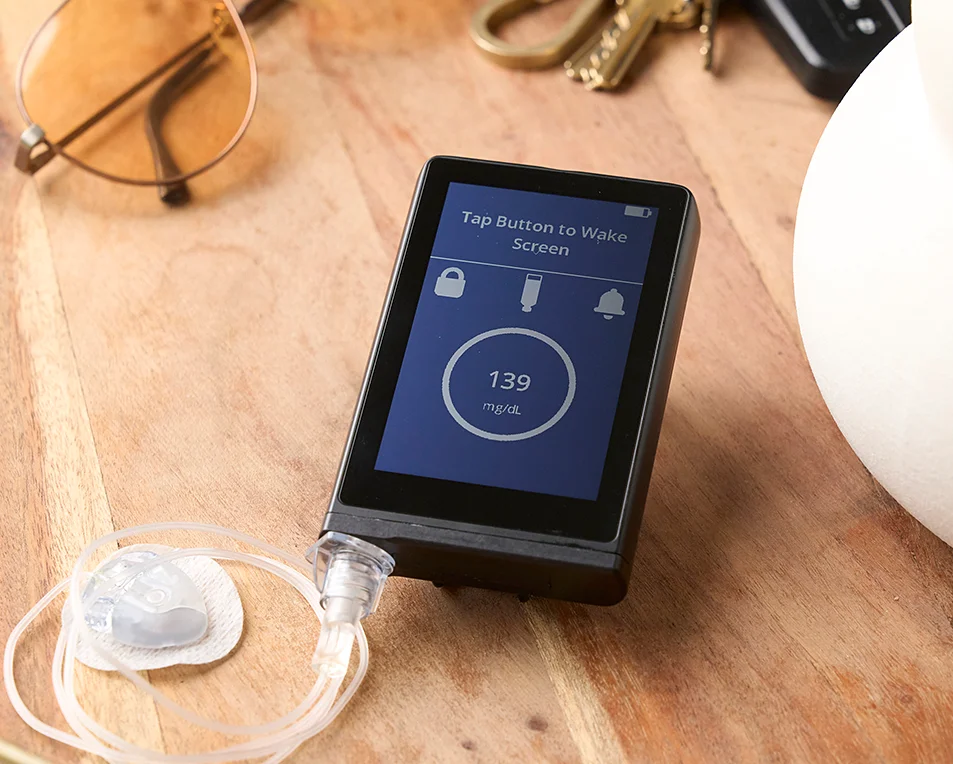
Sign up for a new account.
And get access to
The latest T1D content
Research that matters
Our daily questions
Sign up by entering your info below.
Reset Your Password
Don't worry.
We will email you instructions to reset your
password.
The iLet ACE insulin pump and iLet Dosing Decision Software from Beta Bionics were approved by the FDA on May 19, 2023, for use in children and adults with type 1 diabetes (T1D). While there are several closed-loop systems on the market today, this technology does offer several unique features.
Here’s a closer look at the iLet ACE system — developed by Ed Damiano, co-founder and executive chair of Beta Bionics, and his team.
Getting it started is simple
The iLet system requires zero programming beyond entering your body weight — making it especially easy for primary care doctors to prescribe and manage with assistance from the remarkably easy-to-read “provider guide”.

The iLet system does not have any complex basal rates, insulin-to-carbohydrate ratios, correction factors, temp basal rates, or square wave boluses. In fact, you don’t even need to count specific amounts of carbohydrates.
“It’s like a self-driving car,” says Damiano, who realizes that for some people with T1D, the idea of letting go of the “wheel” can be scary.
“If you’re a ‘knob turner’ who likes to titrate all your doses, this could give you anxiety at first — but that’s why we’re offering a 90-day return policy, so you can see what it feels like.”
Considering 80 percent of people with diabetes struggle to meet their goals, eliminating the need for complex math and titrating will likely be a game-changer.
No math, no carb counting, no big decisions
“I never thought the single-hormone iLet was going to be our first finished product because I didn’t realize how much more time the bi-hormonal system would require,” explains Damiano, a biomedical engineer who began his pursuit of a “bionic pancreas” shortly after his son was diagnosed with T1D at only 11 months old in 2000.
When Damiano first set out to develop life-changing diabetes technology with his PhD Student Firas El-Khatib at the University of Illinois and then later at Boston University, he envisioned a bi-hormonal insulin pump that would automatically adjust and dose both insulin and glucagon in response to continuous blood glucose data.

This dual-hormone approach would strive to proactively prevent both low and high blood sugars. But the glucagon available in early 2000s simply wasn’t stable enough for the task — because it breaks down too quickly, which meant the pump would require daily replenishing. The FDA required the glucagon chamber to be replenished every 27 hours in clinical studies that his team conducted with their collaborators at the Massachusetts General Hospital. While they conducted extensive testing using pigs, a bi-hormonal pump simply wasn’t feasible for commercial use in humans.
Around 2015, in parallel with their work on developing and testing their bi-hormonal pump, Damiano and his team began to pursue a single-hormone pump that requires zero intensive programming or management
“The iLet ACE pump is so different than anything else out there,” adds Damiano. “We knew we could get this to the market earlier, still fully automated. It makes 100 percent of every dosing decision.”
Instead of entering carb counts, you simply tell the iLet ACE pump if your meal is smaller than usual, usual, or larger than usual
“You still need to have a general understanding of carbohydrates,” explains Damiano. “You need to know if there are carbs on your plate, but it doesn’t care how many grams of fat or protein are in a meal.”
If you’ve lived with T1D long enough, that can sound pretty daunting — allowing a machine to understand the difference in dosing insulin for a high-carb meal of quickly digesting cereal versus a slow-digesting pizza — but Damiano says the algorithm’s constant communication between CGM and insulin pump is how it learns your body’s insulin needs and how to adjust dosing throughout the day, regardless of what you eat.
So simple that your primary care doctor can manage it
“75 percent of counties in the U.S. do not have even one endocrinologist,” explains Damiano. “Whereas 95 percent of counties in the U.S. have at least one primary care physician. Consequently, many people with T1D are seeing primary care physicians for diabetes management.”
This means getting and managing most insulin pump systems is incredibly challenging. Most primary doctors will not prescribe a closed-loop insulin pump because of the complex programming and management.
“Other systems require the doctor to establish specific basal rates, carb ratios, correction factors,” says Damiano. “They are unambiguously the most complicated devices to use, and they require sub-specialty physicians to manage them with ongoing tweaking, monitoring, and data analysis.”
The iLet ACE system aims to be simple enough for a primary care doctor to prescribe and manage.
“The setup is simple,” adds Damiano, “you just enter the patient’s body weight, and it begins dosing insulin.”
The algorithms that manage your insulin dosing
While trusting a device to do so much thinking for you is inevitably terrifying after years of managing micro-doses of insulin 24 hours a day, the iLet’s algorithm is intended to do the thinking along with a hefty dose of caution.
“When you eat an amount of carbs more than about slice of bread, you simply do a ‘meal announcement’,” explains Damiano. In other words, the iLet ACE system doesn’t even require a meal bolus for smaller meals or snacks.
Here’s a closer look at the three algorithms working together to automatically manage your insulin doses:
- Basal rate: This algorithm begins with an estimate based on your body weight which is fine-tuned quickly as the pump learns your insulin needs through CGM data.
- Corrections: This algorithm checks in 12 times per hour to make additional adjustments to your basal insulin dosing according to data from your CGM. It is recognizing patterns, adapting, and learning.
- Meal announcement: This is the only algorithm that requires some participation from the patient. When you begin eating, you simply announce that you’re eating breakfast, lunch, or dinner. (There is no snack option because smaller meals are easily covered by the other automatic algorithm dosing adjustments.) It’s never giving the full estimated dose for the meal all at once. It’s conservative but successful because it continues making adjustments in the hours after eating that meal to help you stay in your target range.
What’s the target blood sugar?
The iLet ACE system offers three target ranges. Continuing to keep it simple, the target blood sugar options are defined as:
- “Lower than usual” — target of 110 mg/dL
- “Usual” — target of 120 mg/dL
- “Higher than usual” — target of 130 mg/dL
“The majority of people will find that the usual target works best for them,” explains Damiano.
According to a recent report, adults and children on the iLet ACE system spent an additional 2.6 hours a day with their blood sugars between 70 to 180 mg/dL compared to other methods of managing their insulin.
What happens if your CGM stops working?
If your CGM stops working for any number of reasons, how does the iLet ACE system decide how much insulin to give? It does offer a “BG-run Mode” which allows the user to enter blood glucose numbers from a finger stick once every four hours in order to keep the automated dosing system operating.
No manual mode or “temp basal”? What about exercise?
The iLet ACE system’s weakness is exercise. There is no “temp basal” or “manual” option which means you cannot tell the system to significantly reduce the basal or correction dose of insulin in the hours before and during exercise. However, you can raise the glucose target before and during exercise if you choose to stay connected to the iLet during exercise.
Damiano said that another approach is to simply disconnect from the system prior to exercise that induces hypoglycemia (primary aerobic/cardio exercise) — and then simply reconnect during or after your workout. The iLet system will help you get in range after reconnecting if your blood sugar rises during exercise.
Considering the tremendous complexities of exercise with T1D, this lack of programming options around physical activity is the downside of the otherwise impressively advanced technology. Essentially, the user with T1D will have to establish their own routines before and during exercise.
For people with limited expertise and skill in managing insulin around exercise, however, the iLet could be a vast improvement regardless of its limitations.
Still working on the bi-hormonal bionic pancreas
Finally, thanks to the innovation behind emergency glucagon products like Gvoke, Zegalogue, and Baqsimi, glucagon is finally advanced enough for Damiano to continue the pursuit of his bi-hormonal technology.
These modern glucagon options offer stable, pre-mixed, ready-to-go glucagon — eliminating the obstacle of needing to replenish the glucagon in Damiano’s bi-hormonal insulin pump.
Damiano and his team will be launching the bi-hormonal clinical trial in late 2023 or early 2024 with two phases. The first phase will include about 50 to 100 participants. The second phase will include about 700 participants. He expects it will be the largest closed-loop system study to date, and the trial itself will take about two years.
“Then it takes six months after the study to submit to the FDA,” explains Damiano. “Then another year after that to hopefully receive FDA approval.”
The iLet system doesn’t care how much you know about diabetes
The truest value in this unique closed-loop system is how easy it is to operate thanks to its “enter your body weight and get started” programming. That remarkably simplified system is the result of tremendously advanced technology that strives to make successful diabetes management achievable for anyone.
“In trials on the iLet ACE system,” adds Damiano, “we had one participant with an A1c 14.9 percent initially. By the end of the trial, their A1c was cut more than in half by the iLet to 6.8 percent. I can’t think of a single insulin-delivery device in T1D that’s ever done that before, and it was achieved by a device that was initialized only by entering the user’s body weight.”
“The iLet doesn’t care if you’re good at managing diabetes or how much you know about insulin delivery,” explains Damiano. “We see very little difference in the A1c the system will achieve across race and ethnicity, annual household income, baseline therapy type, or education level. It doesn’t discriminate.”
Ginger Vieira
Related Stories
3 Comments
How the iLet ACE Closed-Loop Insulin Pump is So User-Friendly Cancel reply
You must be logged in to post a comment.








Wow I would love to use the iLet closed loop system especially since I wouldn’t have to react and over ride my pump/CGM constantly. Where do I sign up???
Cindy! I’m sure if you visit the Beta Bionics website, their customer service team will take great care of you and guide you through the process.
Did you ever get this pump? I just got trained today and have some questions if you are willing to help. Thanks!!